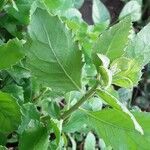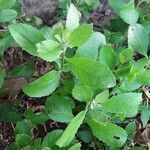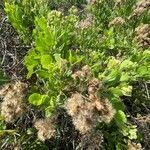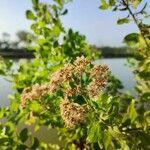Shrubs, erect, to 2 m tall, sulcate-striate, much branched, branches finely shortly crisp hairy, later glabrate. Leaves sessile or very shortly petiolate, obovate, 2.3-8 × 1-4 cm, thickly papery, abaxially loosely puberulent to subglabrous, adaxially minutely puberulent, veinlets distinct, base attenuate, margin acutely dentate, apex acute to mucronate. Capitula narrowly cylindric to campanulate, 5-6 mm in diam. when fresh, to 9-10 mm in diam. in dried specimen, 6-7 mm, in dense terminal and axillary corymbs; peduncle 0-10 mm. Involucre ovate, 4-6 mm; phyllaries 6-or 7-seriate, outer ones 2-2.5 × ca. 1.5 mm, margins ciliolate, apex obtuse, inner lanceolate to linear, 4-6 × 0.25-1 mm, margins entire, apex obtuse. Receptacle densely hirsutulous. Marginal florets numerous; corolla 3-5 mm; style greatly exserted; achenes brown, cylindric, with 5-7 pale ribs, slightly curved, ca. 1 × 0.3 mm, subglabrous; pappus white, ca. 5 mm, slightly exceeding corolla. Central florets 2-7; corolla 4.5-5.5 mm, 5-lobed, lobes glandular; anthers and style greatly exserted; achenes vestigial; pappus white, as long as corolla. 2n = 20, 60.
More
Woody shrub to 2 m high, bisexual. Stems terete. Leaves sessile, obovate to narrowly obovate, 20–70 mm long, 10–30 mm wide, 1.7–3.3 times longer than broad, denticulate or dentate, acute, not resinous; both surfaces glabrous or with sparse to moderate cover of non-glandular hairs; glands present, transparent. Capitula narrowly campanulate, 4–5.5 mm long, in clusters of (1–) 2–4; peduncles absent; outer involucral bracts pilose, sometimes glandular, with fimbriate margins; inner bracts linear, 3.5–4.5 mm long, 0.2–0.3 mm wide, acute or obtuse, glabrous on outer surface, with upper margins fimbriate. Disc florets 1–4; corolla tube expanded towards apex, 3.0–4.5 mm long, pink; lobes 5, 0.5–0.6 mm long, glandular. Fertile achenes produced only by marginal florets, cylindrical, 0.6–1.0 mm long. Pappus bristles of marginal florets 18–25, 2.4–3.7 mm long. [See also Du Puy et al. 1993: 416–417.]
A small shrub. It grows 1-3 m high. It has many branches from the base. The leaves are alternate and simple. They are 1-2.5 cm long by 6-8 mm wide. The flowers occur in a panicle of heads at the ends of branches. The flower heads are 3 mm across. They are mauve. The fruit is a brown nut about 1 mm across.
A tropical plant. It often grows in salty locations. It grows around the coast. It is often near sea level and in mangroves. It grows in wetlands. It can be on hard, stony ground. In Java it grows up to 1,000 m above sea level.
More
Occurs especially along the sea shore and tidal streams and swamps, on clayish or hard and stony soils, occasionally near salt-springs in the interior, in sunny or slightly shaded localities.
Grows in saline areas at the edge of the mangrove zone or in coastal Melaleuca forest in damp sandy soils.




